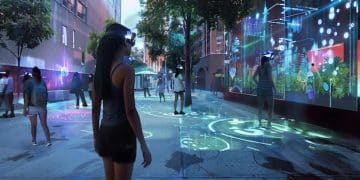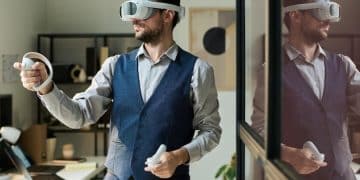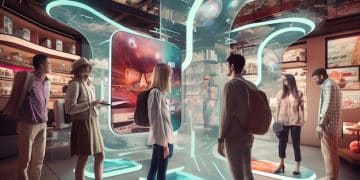AR Revolutionizing US Retail: Enhance Experiences Now

Augmented Reality (AR) is transforming the US retail landscape by offering immersive, interactive, and personalized shopping experiences that bridge the gap between physical and digital worlds, driving engagement and sales.
The retail sector, a cornerstone of the US economy, is constantly seeking innovative ways to captivate consumers and optimize operations. In this relentless pursuit of evolution, a technology poised to redefine engagement and elevate the traditional shopping journey has emerged: Augmented Reality (AR). How is Augmented Reality (AR) enhancing US retail experiences, transforming mere transactions into memorable interactions?
The advent of AR in retail: where virtual meets reality
Augmented reality, often described as a live, direct or indirect view of a physical, real-world environment whose elements are “augmented” by computer-generated sensory input such as sound, video, graphics, or GPS data, is proving to be a game-changer for US retail. Unlike virtual reality (VR), which creates entirely simulated environments, AR overlays digital information onto the real world, enhancing what we already see.
The integration of AR in retail is not merely a technological gimmick; it is a strategic move to address evolving consumer expectations. Today’s shoppers seek more than just products; they crave experiences. They desire personalization, convenience, and the ability to make informed decisions without leaving the comfort of their homes or enduring the frustrations of crowded stores. AR responds to these demands by providing tools that make shopping more interactive, informative, and engaging.
Bridging the gap between online and offline shopping
One of AR’s most significant contributions to US retail is its capacity to blur the lines between e-commerce and brick-and-mortar stores. This hybrid approach, often termed “phygital,” leverages the strengths of both channels. Online, AR apps allow customers to try on clothes virtually, visualize furniture in their homes, or preview makeup shades, reducing the uncertainty associated with impersonal digital purchases.
- Virtual try-on solutions for apparel and accessories.
- Product visualization tools for home goods and electronics.
- Interactive in-store navigation and information overlays.
In physical stores, AR can enhance the in-store experience by providing immediate access to product details, customer reviews, or even personalized recommendations directly through a customer’s smartphone or an in-store AR mirror. This enriches the conventional shopping trip, making it more dynamic and responsive to individual needs.
The foundational principle is clear: AR isn’t about replacing established retail models but augmenting them. It delivers a layer of digital convenience and richness that was previously unattainable, creating a seamless and satisfying shopping journey irrespective of the channel chosen by the consumer.
Transforming product visualization and try-on
Perhaps the most immediate and tangible impact of augmented reality in US retail is evident in how consumers interact with products before making a purchase. The traditional challenges of online shopping—namely, the inability to physically interact with an item—are being systematically dismantled by AR applications designed for product visualization and virtual try-on.
For furniture retailers, AR apps allow potential buyers to scan their living rooms or bedrooms and virtually place true-to-scale digital models of furniture items within their existing space. This not only helps customers assess aesthetics but also practical considerations like size and fit, significantly reducing the likelihood of returns. This capability translates directly into higher customer satisfaction and lower operational costs for businesses.

Virtual try-on for fashion and beauty
In the highly visual and personal sectors of fashion and beauty, AR is a revelation. Imagine trying on dozens of lipstick shades or experimenting with different hairstyles without ever touching a physical product. Brands are deploying AR filters and apps that use facial recognition to perfectly overlay cosmetics, eyewear, or even jewelry onto a customer’s real-time image. This provides an unprecedented level of confidence in online purchases and offers a playful, engaging experience that encourages experimentation.
- Seamless integration with e-commerce platforms.
- Personalized recommendations based on virtual try-on results.
- Reduced hygiene concerns for cosmetics and accessories.
The feedback loop is also critical. When customers can see how products will look on them or in their intended environment, they are more likely to make a purchase they are genuinely happy with. This proactive approach to customer satisfaction is a hallmark of AR’s transformative power in retail.
Beyond the direct benefits to the consumer, retailers gain valuable data insights from these interactions. Analytics derived from AR product engagements can inform inventory management, personalized marketing campaigns, and even future product development, creating a virtuous cycle of innovation and improved service.
Enhancing in-store navigation and personalized marketing
While often celebrated for its online capabilities, augmented reality is equally powerful in revolutionizing the brick-and-mortar retail experience. Traditional stores, once static environments, can be transformed into dynamic, interactive spaces through the intelligent application of AR, significantly improving customer journeys and optimizing marketing efforts.
Consider the expansive aisles of a large supermarket or a multi-floor department store. For many shoppers, navigating these spaces can be overwhelming. AR-powered indoor navigation systems allow customers to input a shopping list or a specific item, and their smartphone or smart glasses can overlay directions directly onto their view of the store, guiding them efficiently to their desired products. This reduces frustration, saves time, and enhances overall store efficiency.
Contextual information and interactive displays
Beyond navigation, AR offers a powerful platform for delivering contextual product information. By pointing their device at an item, customers can immediately access details such as ingredients, origin, sustainability credentials, customer reviews, and even complementary product suggestions. This real-time access to rich information empowers shoppers to make more informed decisions right at the point of sale, fostering trust and transparency.
- Interactive product demos and tutorials.
- Gamified elements to encourage exploration.
- Augmented fitting rooms for style advice.
Personalized marketing also receives a significant boost. As customers move through a store, AR can recognize their location and previous interactions, pushing hyper-relevant promotions or personalized recommendations directly to their devices. Imagine walking past a display of running shoes, and an AR notification pops up offering a discount on a pair you previously viewed online, or suggesting a complementary fitness tracker. This level of personalized engagement cultivates a stronger bond between the customer and the brand.
The fusion of AR with in-store environments creates not just a smarter store, but a more responsive and intuitive one, where every interaction is tailored, and every piece of information is readily available, fundamentally reshaping the retail experience.
Driving engagement through gamification and immersive experiences
In an increasingly competitive retail landscape, capturing and retaining customer attention is paramount. Augmented reality provides a unique avenue for retailers to differentiate themselves by transforming the act of shopping into an entertaining and memorable experience. Gamification, powered by AR, is proving to be an exceptionally effective tool for boosting engagement and fostering brand loyalty.
Retailers are leveraging AR to create interactive games that encourage customers to explore products, learn about brands, and even earn rewards. For instance, an AR scavenger hunt within a store can guide customers to different departments, rewarding them with discounts or exclusive content upon finding virtual objects. This playful approach not only increases time spent in-store but also makes the shopping journey more enjoyable and less transactional.
Experiential marketing with AR
Beyond direct gamification, AR enables retailers to craft deeply immersive brand experiences. Pop-up AR installations, virtual portals to exotic locations, or interactive storytelling elements can be deployed in-store or even in public spaces to captivate audiences and create buzz. A beauty brand might offer an AR mirror that allows customers to digitally try on celebrity make-up looks, while a car dealership could let prospective buyers “walk around” and customize a virtual car model in their parking lot.
- Interactive brand storytelling.
- Augmented reality art installations.
- Virtual product launches and events.
These experiences go beyond simple product display; they create emotional connections and reinforce brand identity in powerful ways. They provide shareable moments that extend a brand’s reach organically through social media, as customers eagerly share their AR adventures with friends and followers. This form of experiential marketing builds brand affinity and distinguishes retailers in a crowded market.
By transforming passive browsing into active participation, AR empowers retailers to create vibrant, dynamic environments that not only sell products but also build communities and lasting relationships with their customer base, moving beyond mere commerce to true connection.
Operational efficiencies and data collection
While the front-end benefits of augmented reality for customer engagement are widely celebrated, AR also offers substantial advantages for retailers behind the scenes, contributing to operational efficiencies and providing invaluable data insights. This dual capability makes AR a truly transformative technology for the US retail sector.
In warehouses and stockrooms, AR can assist employees with inventory management and order fulfillment. AR glasses can overlay pick lists onto a worker’s view, guiding them directly to specific product locations, highlighting quantities, and even confirming items as they are selected. This hands-free approach enhances accuracy, significantly reduces picking errors, and speeds up the entire fulfillment process, translating into faster delivery times for customers and reduced labor costs.
Training and maintenance with AR
AR is also proving beneficial in employee training and equipment maintenance. New retail staff can receive interactive, on-the-job training using AR overlays that provide instructions for setting up displays, operating POS systems, or handling specific products. For complex machinery, AR can guide technicians through repair procedures, overlaying diagrams and step-by-step instructions directly onto the equipment, minimizing downtime and the need for specialized on-site experts.
- Streamlined stock checking and replenishment.
- Remote assistance for store operations.
- Optimized shelf space management.
Crucially, AR interactions generate rich data. Every virtual try-on, every product visualization, and every AR-guided navigation provides insights into customer preferences, popular products, areas of high engagement, and even pain points in the shopping journey. This data is far more granular and context-rich than traditional e-commerce analytics or in-store observational data. Retailers can use these insights to refine product offerings, personalize marketing strategies, optimize store layouts, and even predict future trends with greater accuracy.
The synergy between enhanced customer experiences and improved internal operations solidifies AR’s position as a multifaceted tool, driving not just revenue but also efficiency and strategic foresight for retailers across the United States.
Challenges and the future outlook for AR in US retail
Despite its undeniable potential and growing adoption, the widespread implementation of augmented reality in US retail still faces several challenges, ranging from technological hurdles to consumer adoption rates. Addressing these will be crucial for AR to fulfill its promise as a cornerstone of future retail experiences.
One primary challenge is hardware accessibility and cost. While most modern smartphones support AR apps, the experience often benefits from dedicated AR glasses or more powerful computing devices. The cost and widespread availability of these advanced AR devices remain barriers for mass consumer adoption. Furthermore, developing sophisticated AR applications requires significant investment in talent and infrastructure, which can be prohibitive for smaller retailers.
Ensuring seamless user experience and data privacy
For AR to truly take hold, the user experience must be seamless and intuitive. Clunky interfaces, slow loading times, or inaccurate Augmented reality renderings can quickly lead to user frustration and disengagement. Ensuring high performance across a diverse range of devices and network conditions is a continuous challenge. Furthermore, as AR applications collect more data on user interactions and environments, data privacy and security concerns become paramount. Retailers must establish robust protocols and transparent policies to build consumer trust.
- Standardization of AR development platforms.
- Integration with existing retail infrastructures.
- Educating consumers on AR benefits.
Looking ahead, the future of AR in US retail appears robust and promising. Advances in 5G networks will provide the necessary bandwidth for richer, more immersive AR experiences, reducing latency and enabling real-time interactions. The decreasing cost and increasing capabilities of AR hardware, including lightweight smart glasses, will eventually make the technology more accessible to the general public.
As retailers become more proficient in leveraging AR and consumers become more accustomed to its benefits, we can expect to see AR move beyond novelty to become an indispensable part of the retail journey. The evolution will likely involve more integrated AR experiences, where the technology is embedded into daily life rather than being a separate app, making shopping more intuitive, informed, and enjoyable than ever before.
| Key Point | Brief Description |
|---|---|
| 🛍️ Product Visualization | Allows customers to virtually “try on” products or see them in their environment before purchase, reducing returns. |
| 📍 In-Store Navigation | Guides shoppers through large stores efficiently, locating items and offering contextual information. |
| 🎮 Gamification & Engagement | Transforms shopping into an interactive and entertaining experience, increasing brand loyalty. |
| 📊 Operational Efficiencies | Aids in inventory management, employee training, and provides valuable consumer data insights. |
Frequently Asked Questions about AR in US Retail
▼
Augmented Reality in retail overlays digital information onto the real world, enhancing a customer’s perception of products and shopping environments. Unlike virtual reality, which creates fully immersive, simulated worlds, AR allows users to interact with virtual elements within their real surroundings, such as trying on clothes virtually or visualizing furniture in their home.
▼
AR significantly benefits online retail by addressing the lack of physical interaction with products. It enables virtual try-ons for apparel and beauty, and product visualization for home goods, allowing customers to see how items look before purchase. This reduces uncertainty, boosts buyer confidence, and ultimately lowers product return rates, improving profitability for retailers.
▼
Yes, AR enhances in-store shopping by offering features like interactive navigation, guiding customers to specific products. It provides instant access to product information, reviews, and personalized offers through smartphone integration or smart mirrors. This transforms traditional stores into dynamic, engaging spaces, making shopping more efficient and personalized for consumers.
▼
Widespread AR adoption in retail faces challenges including the cost and accessibility of advanced hardware like dedicated AR glasses. Developing high-quality AR applications requires significant investment. Additionally, ensuring a seamless user experience across various devices and addressing data privacy concerns are critical hurdles that need to be overcome for broader integration.
▼
AR contributes to operational efficiency by streamlining tasks such as inventory management and order fulfillment in warehouses. It can assist employees with hands-free picking guides, reducing errors and speeding up processes. AR also supports training new staff and provides remote assistance for equipment maintenance, leading to overall cost savings and improved productivity.

The augmented reality revolution: a new chapter for US retail
In conclusion, augmented reality is not merely a fleeting trend but a fundamental shift in how consumers interact with products and brands across the United States retail landscape. From transforming the tactile experience of product visualization and virtual try-ons to revolutionizing in-store navigation and marketing, AR is proving its value by enhancing engagement and personalizing the customer journey like never before. While challenges such as hardware accessibility and seamless user experience persist, the trajectory for AR’s integration into retail is undeniably upward. As technology matures and consumer familiarity grows, AR will continue to bridge the gap between the physical and digital, creating more efficient operations for businesses and richer, more intuitive, and highly enjoyable shopping experiences for consumers. The future of US retail is undoubtedly augmented, promising a dynamic and immersive era for both shoppers and sellers.





